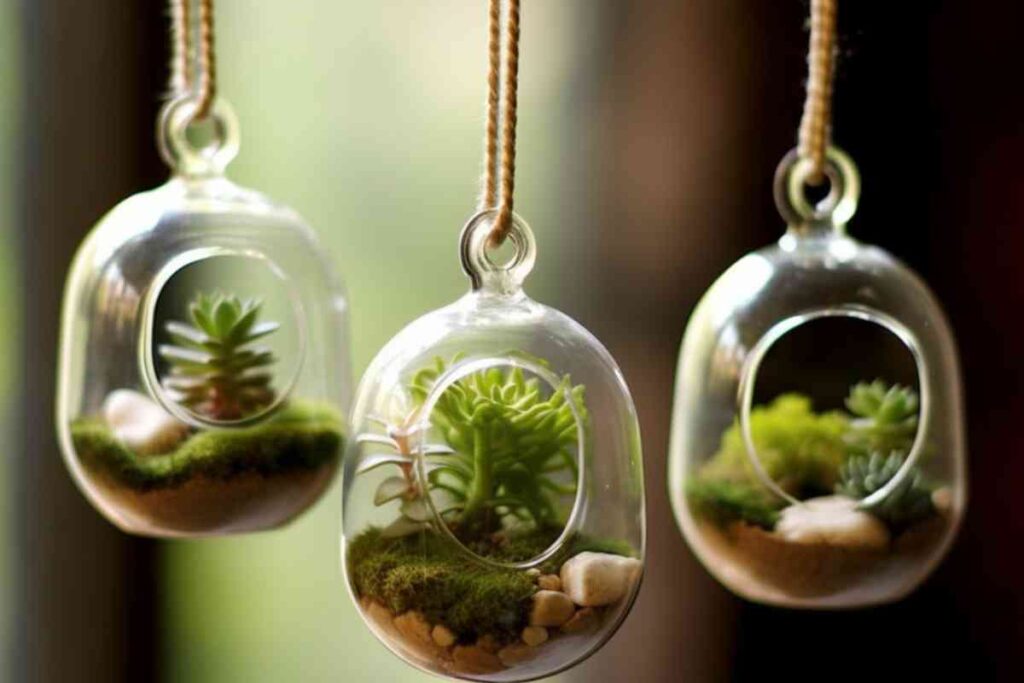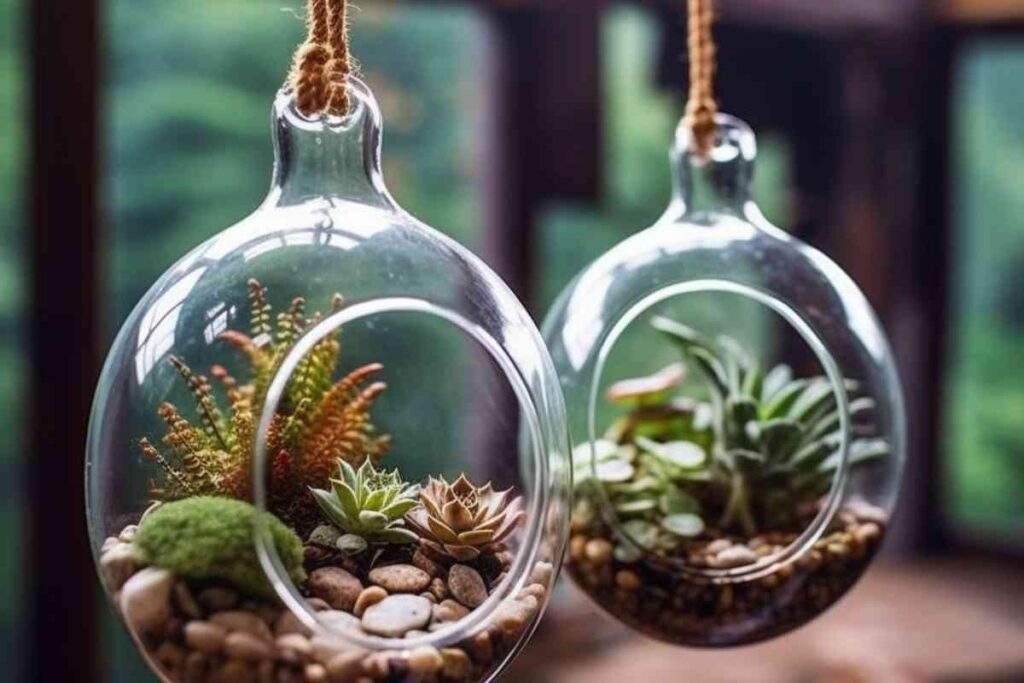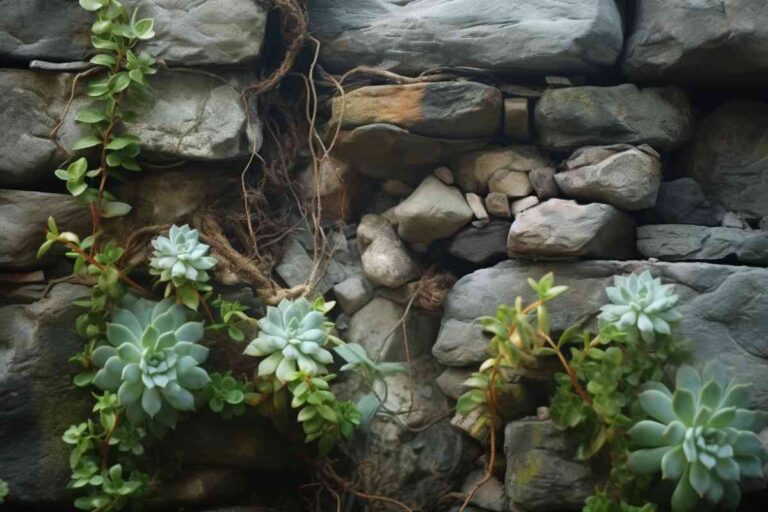How to Make a Hanging Terrarium for Succulents: Step-by-Step Guide

If you’ve heard from me on the subject of glass terrariums for succulents before, you probably know that this article is getting a disclaimer. A terrarium is NOT the best way to grow succulents. It is, however, among the most adorable ways to grow succulents.
If you want to give it a go (and I know you do) I’ll tell you how to get the best possible results from a less-than-ideal growing situation.
Because, although I preach against terrariums for succulents, I have definitely not practiced what I preach. I’ve made A LOT of succulent terrariums. I don’t recommend it, but I get it. They’re just so pretty.
In this article, I’ll tell you everything you need to know about how to make a hanging terrarium.

I’ve finally figured out how to get them to survive pretty well in terrariums, and I’m going to share that knowledge with you now.
Want to make a cool hanging planter that your succulents will thrive in? These miniature succulent planter ideas work perfectly with hanging planters; just be sure that the planter you choose has drainage.
These general tips and ideas for making succulent arrangements are perfect for inspiring your next creation.
Hanging Succulent Ideas
Terrarium with Holes or a Hook for Hanging
Look for a terrarium specifically designed for hanging, which may have built-in holes or a hook for easy suspension. These terrariums often come in various shapes, such as orbs, teardrops, or geometric forms, adding an interesting visual dimension to your hanging display. Aim for a terrarium with a large enough hole to easily work with and allow for sufficient air flow.
Macramé Hanger
Choose whatever terrarium you want and create a custom macramé hanger to suspend it. Macramé is a popular technique for creating decorative plant holders using knots and cords.
You can find numerous macramé tutorials and patterns online to craft a unique hanger that complements your succulent terrarium.
Decorative Sand Designs
Enhance the visual appeal of your hanging terrarium by incorporating decorative sand or colored gravel into the design. Use different shades or layers of sand to create captivating patterns or gradients beneath the succulents.
Choose a taller terrarium that can show off your sand pattern. Find a simple plastic pot that fits neatly inside, with room all around it. Pot the succulents into the pot with a well-draining soil like I’ll describe later in this article and settle the pot into the center of the terrarium.
Then, layer your sand design around the outside in whatever decorative pattern you choose.
The effect is of succulents growing out of sand, but you won’t have to worry about the moisture-holding qualities of fine sand that would otherwise doom your succulents.
All of my friends ask me how I get succulents to survive in decorative sand terrariums. Now you know my trick!

Hanging Terrarium Chandelier
Take your hanging succulent display to the next level by creating a terrarium chandelier. Combine multiple terrariums at different heights and suspend them from the ceiling. This creates a stunning focal point and allows you to showcase a collection of succulents.
To create a Hanging Terrarium Chandelier, you’ll need a sturdy frame or structure from which to suspend the terrariums. This can be a repurposed chandelier frame, a wire grid, or any other ceiling-mounted structure that can support the weight of the terrariums.
Choose a variety of terrariums in different shapes and sizes to create visual interest. Hang them at varying heights from the structure. You can use durable cords, chains, or macramé hangers to suspend the terrariums securely. Arrange them in a cascading or staggered pattern to create a dynamic and visually appealing display.
This design is PERFECT as part of a succulent bedroom design. If your bedroom has bright light for most of the day, a succulent chandelier over the bed is a to-die-for design idea.
Extras for Your Hanging Succulent Terrarium Design
- Consider including air plants (Tillandsia spp.) alongside your hanging succulents. Air plants do not require soil and can be attached to driftwood, stones, or other decorative elements within the terrarium. They add an ethereal and unique element to the hanging display.
- Miniature Figurines or Ornaments: Introduce whimsy and charm to your terrarium by incorporating miniature figurines or ornaments. Choose tiny objects like fairies, animals, or tiny houses to create a miniature scene within the terrarium. Be mindful of the size and scale of the figurines, ensuring they don’t overcrowd the plants.
- Terrarium Terrariums: For a creative twist, consider placing smaller terrariums inside a larger hanging terrarium. Why not right? Put those tiny succulent pups to good use. Just remember to change them out when they start to grow.

Choosing a Container
Select a terrarium that provides enough space for the succulents’ roots to grow BEFORE they get to the reservoir of gravel at the bottom. The shape of the terrarium can also affect the distribution of light, so choose one that allows for even lighting exposure.
Choose a terrarium that allows for the appropriate amount of light penetration. Some terrariums may have clear or transparent sides, while others might have frosted or tinted glass. Frosted glass can be helpful if you want to place the terrarium where it may get some direct sun.
Look for a terrarium with as much ventilation as possible to prevent excess moisture buildup. An open top is best, but a big hole in the side works as well. Proper airflow helps prevent fungal diseases and ensures a healthier growing environment.
Consider how easily you can access the succulents for maintenance tasks such as watering, pruning, or removing any decaying leaves. A terrarium with a wide enough opening or removable lid can make these tasks more convenient.

Preparing the Container
Before planting your succulents in a hanging terrarium, it is important to prepare the container properly to ensure the health and longevity of your plants. There are three key components to preparing the container: creating a drainage layer, adding activated charcoal, and selecting the right potting mix.
Drainage Layer
The first step in preparing the container is to create a drainage layer at the bottom of the terrarium. This layer will help prevent water from pooling at the bottom and potentially drowning your succulents. This step is CRITICAL to keeping succulents in a terrarium.
To create the drainage layer, I like to use coarse gravel. Water won’t seep back up into the other layers if you use coarse gravel.
The thickness of the drainage layer will depend on the size of your container, but a good rule of thumb is to aim for a layer that is approximately 1-2 inches thick. Thicker is better.
Activated Charcoal
The next step in preparing the container is to add a layer of activated charcoal on top of the drainage layer. Activated charcoal helps to absorb any excess moisture in the soil and prevent odors from building up in the terrarium.
To add the activated charcoal, I sprinkle a thin layer on top of the drainage layer. Again, the thickness of the layer will depend on the size of your container, but a thin layer of approximately ¼ inch should suffice.
Potting Mix
Finally, it is important to select the right potting mix for your succulents. Succulents require a well-draining soil mix that is low in organic matter. In a terrarium, they need even better drainage and less organic. I don’t bother with potting soil, compost, or coco coir.
Instead, I make my mix with coarse sand, gravel, and crushed pumice. Even perlite holds too much moisture for succulents. You want this soil to dry out as fast as possible. Here’s a complete guide for mixing your own succulent soil. Just choose from the mineral materials that work for you.

Succulent Species that MIGHT Tolerate a Terrarium
- Haworthia spp.: Haworthias are excellent choices for terrariums due to their ability to tolerate higher humidity levels. They come in a variety of shapes and sizes, such as Haworthia fasciata (Zebra Plant) and Haworthia retusa (Star Cactus).
- Gasteria spp.: Gasterias are another group of succulents that can thrive in terrariums. They have thick, fleshy leaves with interesting patterns. Gasteria verrucosa (Gasteria) and Gasteria batesiana (Ox Tongue) are popular species to consider.
- Rhipsalis spp.: Rhipsalis, also known as Mistletoe Cactus, is a unique succulent that can adapt well to the humid environment of a terrarium. They have long, trailing stems and prefer shadier conditions. Rhipsalis baccifera (Coral Cactus) and Rhipsalis cereuscula (Rice Cactus) are examples to explore.
- Peperomia spp.: While not technically succulents, many Peperomia species have thick, succulent-like leaves that can thrive in terrariums. They are known for their attractive foliage and come in various colors and textures. Peperomia obtusifolia (Baby Rubber Plant) and Peperomia caperata (Ripple Peperomia) are popular choices.
- Sedum spp.: Certain Sedum species can adapt to the higher humidity levels of terrariums. Look for low-growing varieties like Sedum dasyphyllum (Corsican Stonecrop) or Sedum pachyphyllum (Jelly Bean Plant) for a more compact and visually appealing display.

Putting it all Together
- Choose a few larger rocks or stones that will serve as focal points in your design. These can be visually interesting or uniquely shaped rocks that add texture and dimension to the terrarium.
- Carefully place the larger rocks and succulents, considering their visual impact and balance within the space. Arrange them in a way that creates an appealing composition. It helps to place the rocks with the grain running in the same direction as one another, so as to look like a natural outcropping.
- Use the prepared soil to fill in around the base of the larger rocks and succulents. Gently tap the soil so it falls into place around the roots and base of the rocks. Take care not to cover the entire surface of the rocks.
- Select smaller rocks, pebbles, and succulents of varying shapes and colors. Place them strategically around the larger rocks to fill in the empty spaces and create a natural effect. Clustering smaller succulents in same-species clusters creates a natural effect.
- Use the soil to fill in any gaps between the succulents and rocks. Tap it gently around the plants to ensure they are firmly rooted and stable. It helps to tap the entire terrarium gently on the ground as well.
- Add a final layer of decorative gravel or sand: Once the larger rocks, succulents, and soil are in place, add a final layer of decorative gravel or sand over the exposed soil. This top layer not only provides a polished look but also helps retain moisture and minimizes soil erosion. It’s ok to use fine sand for this step if you like. Colored sand can add an interesting effect.
Remember to step back periodically and assess the overall design as you go. Adjust the placement of rocks and succulents as needed to achieve a natural look.
With careful attention to detail, you can create a beautiful and harmonious design that looks like a tiny world in your hanging terrarium. I go into more detail about building a miniature world in my fairy succulent garden article, if you’re interested.
How to Care for Your Succulent Terrarium
Watering
- Observe the soil moisture: Before watering, assess the moisture level of the soil. Insert your finger about an inch into the soil or use a moisture meter to gauge its dryness. Succulents prefer their soil to be dry before the next watering.
- Water sparingly but thoroughly: When it’s time to water, do so sparingly but ensure that the water reaches the entire root zone. Slowly pour water onto the soil surface until you see it draining into the bottom of the terrarium. This ensures that the water has reached the roots and helps flush out any accumulated salts or minerals.
- Allow complete drying: After watering, it’s crucial to let the soil dry out completely before the next watering. Succulents are prone to root rot if they sit in consistently moist or waterlogged soil. The drying period allows the roots to absorb oxygen and helps prevent moisture-related issues. A dehumidifier can help eliminate the water in the reservoir more quickly.
- Adjust watering frequency: The watering frequency will depend on various factors, such as the terrarium’s humidity, temperature, and the specific succulent species. As a general guideline, water your succulent terrarium when the soil has completely dried out. This could range from once every two weeks to once a month or even longer, depending on the conditions.
- Consider the seasons: Succulents have different water requirements based on the season. They often need less water during cooler months when they experience slower growth. Adjust your watering schedule accordingly to avoid overwatering during dormant periods.
- Never mist: Some people will tell you to mist your succulent terrarium. They are wrong. Don’t listen to them. Misting is the last thing you want, as it will raise the humidity in your terrarium and rot the leaves of your succulents.
Humidity
Succulents thrive in dry environments, so it’s important to avoid excess humidity in your terrarium.
To prevent excess humidity, make sure your terrarium has adequate ventilation. Open the lid if there is one to allow fresh air to circulate. You can also place a small fan near your terrarium to promote airflow. A dehumidifier nearby can also help dramatically.
Running a dehumidifier in front of your succulent terrarium directly after watering can help to eliminate the excess water resting in the reservoir and prevent humidity as it evaporates over time.

Light
As a succulent, your hanging terrarium needs plenty of sunlight to thrive. I recommend placing it near a window that receives bright, indirect light for at least six hours a day. Don’t let direct sunlight hit the terrarium since it will scorch the leaves when concentrated through the glass. If you want to put it somewhere it may get direct light, consider getting a terrarium with some frosted glass.
Fertilizing
Succulents don’t require frequent fertilization, but it can help them grow and thrive. Since I don’t have any organic matter in my soil, I use a balanced, water-soluble fertilizer once a month during the growing season (spring and summer). Be sure to dilute the fertilizer according to the package instructions, as succulents are sensitive to over-fertilization.
Conclusion
While hanging terrariums may not be the go-to method for growing succulents, they are undeniably beautiful and fun. With the right design and care, you can create a captivating display that will have your friends and guests oohing and aahing (and asking how on earth you get succulents to grow so well in sand? You don’t have to tell…)
Now that your windows are adorned with gorgeous hanging succulent terrariums, why not try out a succulent table arrangement?
Are the succulents in your hanging terrarium not doing so well? I’ve been there. Here’s what you need to know about how to save a succulent without roots.



